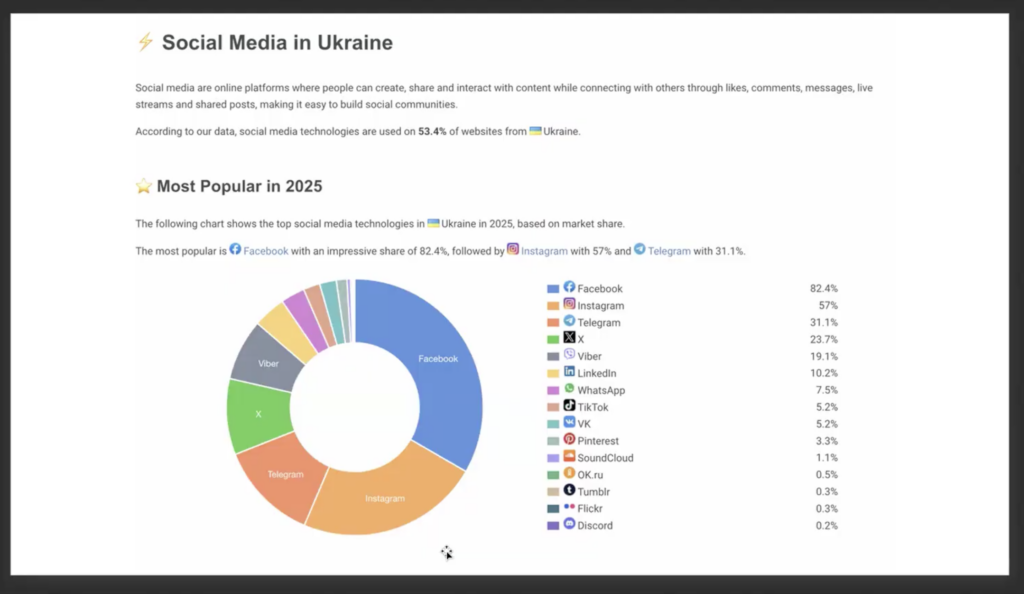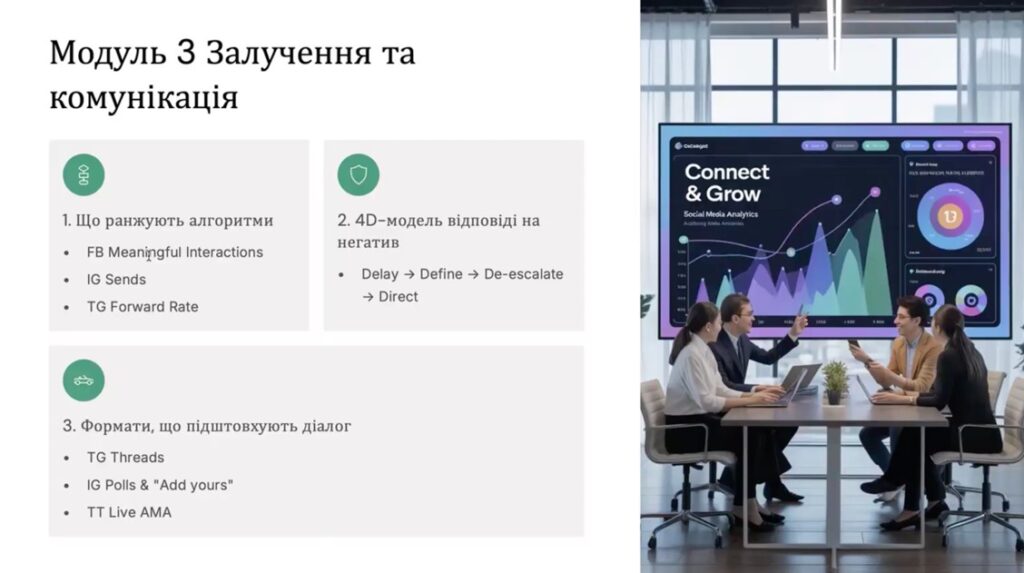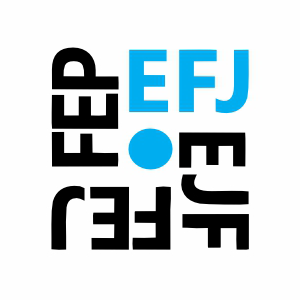Social platforms are a territory with their own traffic, laws, and ‘security algorithms at entry points.’ And if you want them to work for you, you need to learn to play by their rules – from the submission format to the requirements of each social network and to comment moderation. This is what was discussed during the second mentoring session of the National Union of Journalists of Ukraine (NUJU) course, Strengthening the Resilience of Front-line Media, conducted by journalist and media trainer Andrii Yurychko.
In short, whoever “repackages” materials for a specific platform, analyzes their page as a content manager, and conducts a dialogue in the comments, collects reach, trust, and audience conversions. Whoever posts a link with the instruction “read, it’s interesting” – works for anti-statistics and promotes “other people’s resources” on this topic.
Why social networks are an infrastructure for the media, not an “additional source“
At the start of the session, the participants discussed their own practices of using social networks. For some, they are a “fashion of presence,” for others, the main source of topics for further materials.
Editor of Novyny Horodnianshchyny Svitlana Tomash says:
“On social networks, in particular, in groups, I find out people’s moods, what worries them the most, and what questions they would like to hear answers to. I take topics for my future materials from there. I often find out news – usually, official structures have their own pages where they publish news more promptly.”
A colleague from Sumy, Olena Kasatkina, the editor of Panorama, honestly admits that despite attempts to utilize social networks for the newspaper, it has not yet been possible.
“Therefore, for us, they (social networks – author) are more of a source of information, not so much information, but topics for materials.”
And in front-line communities, social networks, primarily social messengers, are also a channel for two-way communication with readers: fast, familiar, and “in your pocket.”
Where does the Ukrainian audience live in 2025

At the beginning of 2025, there were approximately 21.6 million social media identities in Ukraine, accounting for about 56% of the population. A total of 31.5 million people (82.4%) use the Internet. These are DataReportal figures. DataReportal – Global Digital Insights.
Telegram has become the main “feed” for many Ukrainians over the two years of the war. An Internews study recorded a jump to 72% of users who called Telegram the main network for news (2023). Last year, both the media and government agencies drew additional attention to the platform through a discussion about the potentially dangerous informational influence of anonymous or pro-russian channels on the audience. The use of Telegram on official devices of state structures has been prohibited since 2024 for security reasons.
“I often conduct surveys among students and their audience regarding activity on social networks. It turns out that 95% do not post anything, only read, 4% post something from time to time, and 1% post regularly,” shares Andrii Yurychko.
This explains the phenomenon of the “silent majority:” almost everyone reads, only a few write. Editorial content will work if it easily “hooks” the reader in the stream.
A short guide to platforms: from Telegram to YouTube:
- Telegram. Focused on subscribers and views. The advantage is speed and direct notifications. The disadvantage is low moderation and information risks. For newsrooms, brand recognition of the channel and discipline in the format are important.
- TikTok. A “time killer” where viewing and attention retention are decisive. It is worth including the logo and the name of the publication in the video so that the audience remembers the source. Most media outlets are present on this social network, with the expectation that it will become more popular and better monetized over time.
- Facebook. Here, the rating is formed by interactions, including comments, reactions, and shares, as well as how often people have interacted with you in the past. Meta directly describes the principle of “remove–reduce–inform”. It reduces the visibility of “problematic” content, even if it does not formally violate the rules. You need to know this to avoid losing reach. Transparency+1
- Instagram. The main things are reach and “watch time” in Reels and sending messages in Direct. Instagram head Adam Mosseri openly names views/time, likes, and “sends” among the top signals. Plan for this. Emplifi
- YouTube. A separate ecosystem with a long tail of views. The title, description, tags, and subtitles increase visibility and provide accessibility. One of the oldest and most widespread social networks with long-lasting (if properly designed) content.
Why views have “dropped:” stop words, structure, and subs
“Artificial intelligence analyzes content and blocks or stops recommending everything it considers offensive, political influence, advertising, even to regular subscribers. Hate speech, offensive words, mentions of “weapons,” “alcohol,” “tobacco,” “children,” “violence,” “death,” “injury,” “terror,” “fascism,” and the list can be continued – stop words that prevent distribution,” comments Andrii Yurychko. “The second condition is whether you follow the platform’s recommendations for the structure of posts. For example, YouTube responds to whether you have subtitles for people who are deaf or have turned off the sound. A catchy title for the video, extended text content with timecodes of sections, translation into other languages, matching tags – only then do social media algorithms start working for more reach and video views.”
This description of the logic and platforms is consistent with Meta’s policy: the post will not necessarily be deleted, but it will be reduced in distribution by the platform’s resources. The result for the newsroom is the same – single views. You should not use “sharp” words without context; be sure to place content warnings about unacceptable content and add subtitles. Transparency
Unpacking and repackaging: how to make five posts from one text
One newspaper article can be repurposed into a carousel on Instagram, a short video and a static post on Facebook, shorts for Reels/TikTok, and a series of stories – this is “unpacking.”
“As much as I do not analyze local media, in the vast majority, they post a link to the material on the social network with the words “Read it, it’s interesting” or at most – the headline and the first paragraph. And the audience does not read, because the platform has its own format for attracting attention, to which the audience is accustomed,” the expert explains.
Approach #2 – “Repackaging”: We create a format from scratch to meet the specific requirements of a particular network.
“In addition to unpacking, we also talk about repackaging – it’s not just posting material on a social network, it’s creating it to meet the requirements of that social network. For example, for Instagram, a picture and a short message are often enough. For Facebook, where reach is important, it’s worth involving the audience in the discussion, giving them the opportunity to comment on your posts.”
A small life hack – daily “backstages” in stories: the process of working on the material forms a “series” and keeps attention between issues. And for design templates in Canva (yes, it’s banal, but it works). During the mentoring session, the participants were shown how to quickly and easily create a video for Instagram from a regular text announcement.
Analytics for every day: what and how to export
Successful media outlets do not rely on “audience feelings”; they track the history of posts and analyze the data. In Telegram, this is done through the Chat Export Tool in the desktop application, where you can retrieve information about posts in HTML/JSON format. On Facebook, this is done through Download Your Information in the Accounts Center. The Google Analytics service provides website statistics. Then, any convenient AI tool for clustering topics and identifying “peak hours,” booster posts, and the most discussed topics.
What to look for in reports:
- engagement (likes/comments/shares, CTR, “virality”),
- topics and tone,
- time patterns (when to post and how long a post is “live”),
- who your audience is (which segments respond best).
Using the example of the pages of the Ukrainian Journalists’ Union and the Academy of the Ukrainian Press, journalists saw this analysis in practice. For example, the most discussed topics on the official Telegram channel of the Ukrainian Journalists’ Union Spilka news were posts about the deaths of fellow journalists and the activities of the Ukrainian Journalists’ Union in the international arena to protect the rights of journalists. On the Facebook page of the Academy of Ukrainian Press, the most reactions and coverage are generated by posts about the activities of local newsrooms in front-line territories, which are supported by the AUP, exercises/materials on media literacy, countering disinformation, and professional literature.
Such regular analysis, according to Andrii Yurychko, is crucial for social networks to effectively leverage the media.
Comments: ethics, law, and a little humor

Comments should be treated as an extension of the main text. They should often be provoked (with questions) and message chains monitored. Negativity? Andrii advises against playing the “mirror game.” Turn the dispute into a joke – “Thank you for your attention, we work exclusively for you,” “We are glad that you regularly reread our materials and regret that this one caused such a reaction in you.” Be sure to provide a link to another relevant material on your resource in your response. If this is a blatant violation of the terms of use of the platform – likes, insults, or personal threats – file a complaint against the account.
Now, about the legal side of comments, attention to which should be included in the internal regulations of the newsroom.
“According to the new edition of the Law On Media, newsrooms are responsible not only for their content on social networks, but also for the comments under it. For example, suppose someone in the comments to your material calls for the overthrow of the state system or otherwise violates Ukrainian law. In that case, you will receive a warning or a fine from the National Council.”
At the same time, the law provides for a “window of irresponsibility”: if, within three working days after the complaint/instruction of the National Council or the court’s decision to open proceedings, you delete the violation, there is no liability. The latest changes in 2025 have just clarified and simplified this procedure. Freedom Housedetector.mediaNational Bar Association of Ukraine
Strategy for local media: original content and your own website
The primary illusion of social networks is that they can replace websites. In fact, it’s the opposite. After the materials are published in the newspaper, place them on the website, and only then “lead” the audience with posts on the social network. Why? Because search engines value original content on your page, and large Telegram channels and aggregators will always bypass you in the speed of distribution by their audience, but never in local uniqueness.
To this, add the discipline of format: for Facebook – questions that invite the reader to the discussion; for Instagram – short messages with expressive visuals; for YouTube – long videos + shorts; for Telegram – a clear post structure (lead, a message to read, and a “hook” at the end).
Practical little things that pay big dividends
- Subtitles everywhere. This is both accessibility and “quiet viewing” in the feed.
- A steady pace. One high-quality “unpacking” per day is better than 10 chaotic posts.
- The logo and name of the publication are on the video. In TikTok and Reels, this is literally “insurance” for the audience’s memory.
- Be careful with risk “slots”. Even without violations, the platform can reduce the visibility of “low-quality” or sensitive content. Work with context, wording, and warnings. Transparency
- Giveaways and polls. Local media have a high credit score – use it, but transparently and infrequently.
- About Telegram – with a cool head. It provides speed and audience reach, but remember the risks of disinformation and security, which are actively discussed in both Ukraine and the world. Reuters
Voice of the editorial staff
The most important thing in all this is to put yourself in your reader’s shoes. And, no matter how mentoring it may sound, to give him a sense of complicity, says the media trainer. Start with a question head-on, end with a “hook” at the end, and between them – clear paragraphs, human examples, and verified data.
“Social networks are not your tool, not your platform. They have their own rules. Only when you follow these rules can you make them work for you,” concludes Andrii Yurychko.
The project is funded by the Embassy of the Republic of Lithuania in Ukraine within the framework of the Development Cooperation and Democracy Promotion Programme.


 THE NATIONAL UNION OF
JOURNALISTS OF UKRAINE
THE NATIONAL UNION OF
JOURNALISTS OF UKRAINE


![International Media Organizations: peace plan mustn’t envision amnesty for crimes against journalists 7 Ukrainian flag on Independence Square [Maidan Nezalezhnosti] in Kyiv, Ukraine (archive image). EPA-EFE / Oleh Petrasiuk](https://nuju.org.ua/wp-content/uploads/2025/12/maidan-flag-yezhak-2022-350x250.jpg)




![International Media Organizations: peace plan mustn’t envision amnesty for crimes against journalists 11 Ukrainian flag on Independence Square [Maidan Nezalezhnosti] in Kyiv, Ukraine (archive image). EPA-EFE / Oleh Petrasiuk](https://nuju.org.ua/wp-content/uploads/2025/12/maidan-flag-yezhak-2022-120x86.jpg)








Discussion about this post